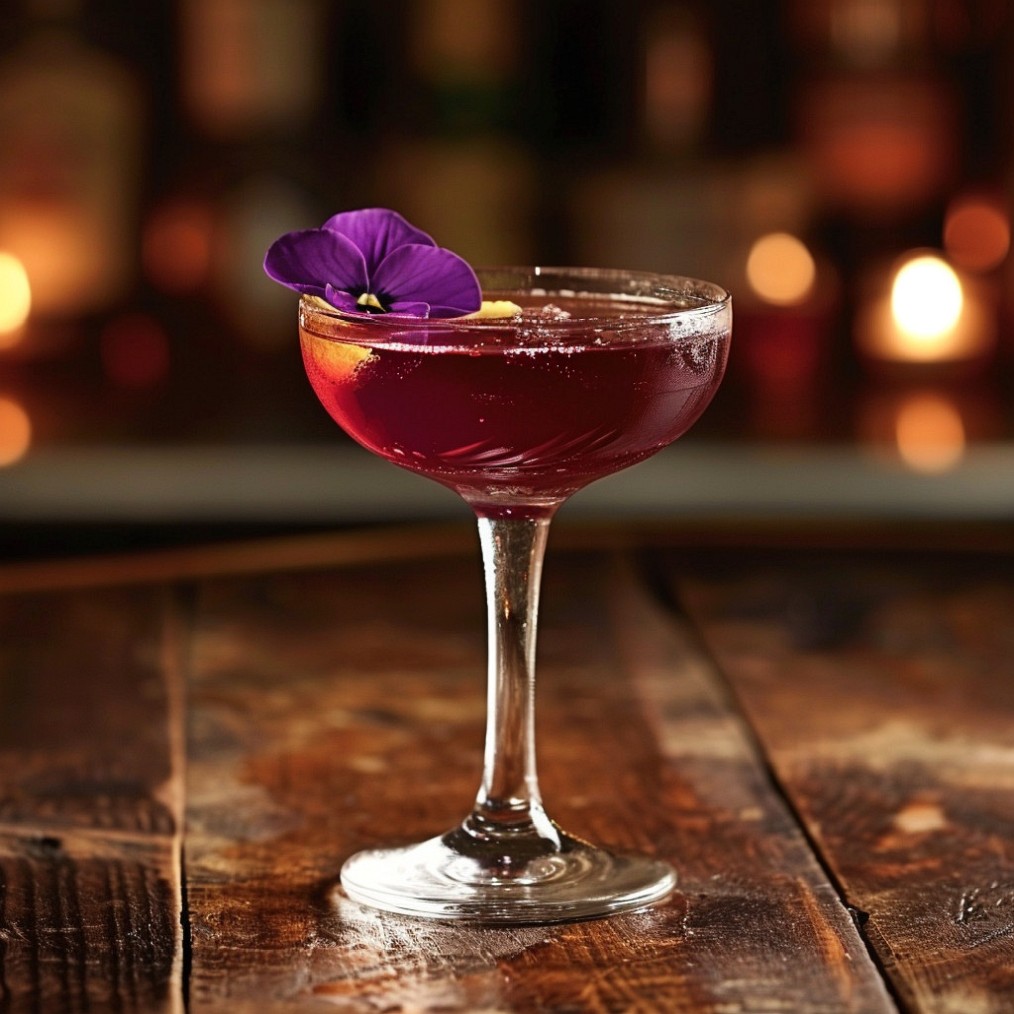
📋 Nutrition Facts
Main Alcohol Gin
Alcohol 14%
Calories 150 calories
Fat 0g
Protein 0g
Carbohydrates 11g
Prep time 5 minutes
The Viola cocktail is like a burst of sunshine in a glass, perfect for those looking to enjoy a refreshing and vibrant drink. This article will dive into the history, taste, and recipe of the Viola, giving you everything you need to make this delightful cocktail. Ready to embark on this flavorful journey? Let’s get started! ⬇️
History
The Viola cocktail was first created in the 1920s. It got its name from the beautiful violet flowers that inspired its color. People loved it because it was both pretty and tasty.
- The name “Viola” comes from the violet flowers.
- It was first made in the 1920s.
- It became popular because it was both pretty and tasty.
The taste of a Viola?
A Viola tastes fruity and floral, with a subtle sweetness that makes it refreshing. The flavors blend together to create a light and delightful drink.
I personally love drinking Violas because they’re incredibly refreshing, especially on a hot day.
Interesting facts about Viola
- The Viola cocktail is known for its beautiful purple color.
- It’s often garnished with edible flowers.
- It became a favorite at garden parties and summer events.
Ingredients 📃
- Vodka: 2 oz (60ml)
- Violet liqueur: 1 oz (30ml)
- Lemon juice: 0.5 oz (15ml)
- Simple syrup: 0.5 oz (15ml)
- Club soda: to top
- Edible violet flowers: for garnish
A Viola is best served in a **highball glass** because it allows the colors and garnishes to be beautifully showcased. Alternatively, a **Collins glass** can also be used for a similar effect.
Recipe. How to make Viola 🍹
- Fill a shaker with ice and add vodka (*2 oz*), violet liqueur (*1 oz*), lemon juice (*0.5 oz*), and simple syrup (*0.5 oz*).
- Shake well until the mixture is chilled.
- Strain into a **highball glass** filled with ice.
- Top with club soda and stir gently.
- Garnish with edible violet flowers.
The Viola cocktail contains sugar and alcohol, so enjoy it in moderation. For a healthier version, you can use natural sweeteners like honey and reduce the simple syrup.
Food Pairings
Certain foods complement the flavors of a Viola, enhancing your overall drinking experience.
Cheese Platter
The floral and fruity notes of the Viola pair beautifully with a variety of cheeses, especially soft and creamy ones.
Seafood
A Viola’s light and refreshing taste complements the delicate flavors of seafood dishes like shrimp or scallops.
Fruit Salad
The natural sweetness of a fruit salad enhances the fruity flavors of the Viola, creating a harmonious pairing.
I really enjoy the taste of Violas—the cool mint and zesty lime make it a perfect drink for relaxing after a long week.
🍸 Mix up your beverage routine
Receive the freshest cocktail recipes and bar trends directly in your inbox.
Bartender Advice
- *Use fresh lemon juice* for the best flavor.
- *Shake thoroughly* to ensure all ingredients are well mixed.
- *Garnish with care* to make the drink visually appealing.
Now that you’ve mastered the classic Viola, in the sections below we’ll shake things up by showing the customizable elements you can alter and introducing a range of exciting variations to try in your next concoction.
What you could change in Viola
- Vodka: Can be replaced with gin for a botanical twist.
- Simple syrup: Can be substituted with honey for a natural sweetness.
- Club soda: Can be replaced with tonic water for a slightly bitter edge.
Viola Variations
Blue Viola
- Ingredients: Replace violet liqueur with blue curaçao.
- Recipe: Follow the same steps, but use blue curaçao.
Rosé Viola
- Ingredients: Add a splash of rosé wine.
- Recipe: Add rosé wine after straining the mixture into the glass.
Mint Viola
- Ingredients: Add fresh mint leaves.
- Recipe: Muddle mint leaves in the shaker before adding other ingredients.
For a non-alcoholic version, simply replace the vodka and violet liqueur with grape juice and a splash of lemon juice. Garnish as usual with edible flowers.
Frequently Asked Questions
What makes the Viola cocktail purple?
The violet liqueur gives the Viola its beautiful purple hue.
Can I use a different type of alcohol?
Yes, you can experiment with gin or even rum for different flavor profiles.
Is the Viola cocktail sweet?
Yes, it has a subtle sweetness from the violet liqueur and simple syrup.
Can I make a Viola without alcohol?
Absolutely! Replace the vodka and violet liqueur with grape juice and lemon juice.
What’s the best garnish for a Viola?
Edible violet flowers are the most popular garnish, adding both beauty and a hint of floral flavor.
How can I make a healthier Viola?
Use natural sweeteners like honey and reduce the amount of simple syrup to make a healthier version.